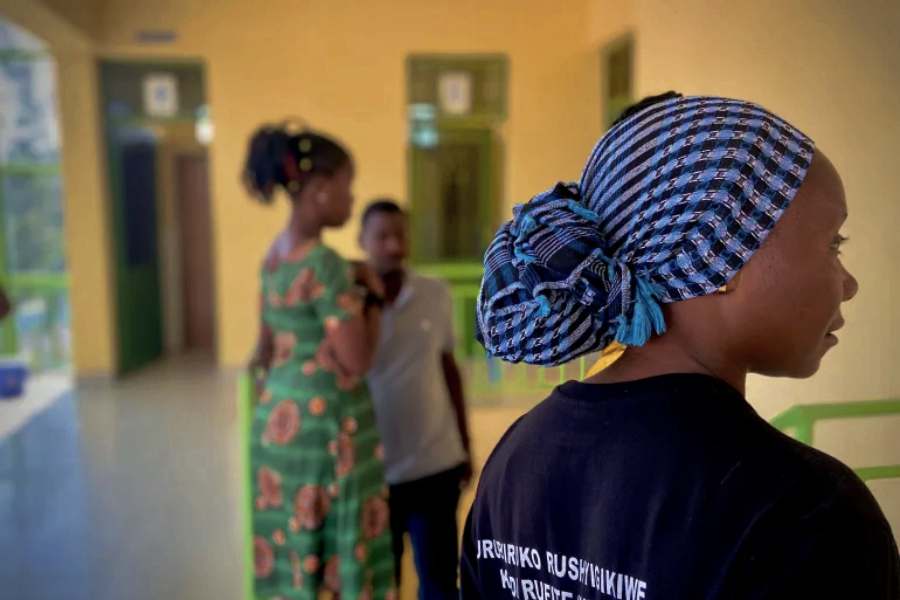![]() Teen mothers gathered at the community centre in Karongi district of Rwanda, July 17, 2023 [Ruchi Kumar/Al Jazeera]
Teen mothers gathered at the community centre in Karongi district of Rwanda, July 17, 2023 [Ruchi Kumar/Al Jazeera]
Tue 29 August 2023:
Previous efforts to combat teen pregnancies were met with success in Rwanda, but that progress has now stagnated.
Kigali, Rwanda – Aime was only 16 years old when she was forced to drop out of school in Karongi district of western Rwanda due to extreme poverty.
Her parents found it difficult to pay her fees so the teenager left to go work for another family in the neighbouring district as a domestic help.
“They had promised to help me get vocational training so I could start my business someday, but they didn’t keep their promise,” Aime told Al Jazeera. Instead, she was not only mistreated by her employers but raped by one of the family members. Her full name has been withheld here to protect her identity.
When she became pregnant, the boy involved said he would take responsibility and offered to support me, but then the family learned about it and immediately dismissed her. When she returned home, her family also disowned her.
“I had brought them shame,” she said, speaking slowly, in measured words, as she described her ordeal.
All of 17, Aime was pregnant, homeless, and facing an uncertain future – a fate she shared with many young girls in Rwanda and the region.
Despite considerable progress in recent years, adolescent pregnancies remain a major concern in sub-Saharan Africa. Globally, the birth rates in 2022, for girls aged 10-14 was estimated at 1.5 per 1000. However, this figure was closer to 4.6 for sub-Saharan Africa, according to data from the World Health Organisation.
In Rwanda, where previous efforts to combat teen pregnancies were successful, progress has now stagnated. According to the most recent Rwanda Demographic Health Survey, released in 2020, the number of underage pregnancies rose from 17,337 in 2017 to 19,832 three years on.
“With the onset of COVID-19, this rocketed to 33,423 in 2022 – amounting to an increase of 17.5 per cent from 2017 to 2022,” Lydia Zigomo, UNFPA’s regional director for East and Southern Africa (ESA) told Al Jazeera. It was observed by WHO that about 5 percent of girls aged 15-19 had begun childbearing at the time, and about 4 percent had given birth.
“Although the teen pregnancy situation in the East and Southern Africa region is slightly better than the sub-Saharan Average [SSA] average … still close to 3.5 million, over half of all adolescent births in SSA, occur in the ESA region,” she added.

Artwork depicting a pregnant Rwandan teen outside the community centre in Karongi district of Rwanda, July 17, 2023 [Ruchi Kumar/Al Jazeera]
‘Twice as likely to die’
Experts have said an increase in adolescent pregnancies translated to negative effect on women’s health and economic status. “Adolescent girls, especially those in early adolescence, are particularly vulnerable to the health consequences of pregnancy and childbirth as they may not be physically and psychologically ready,” Zigomo said.
Niren Ray Maharaj, an obstetrician and gynaecologist at the University of KwaZulu-Natal in South Africa, has observed similar health concerns in adolescent pregnancies.
He told Al Jazeera that depression and mental health issues are also prominent among teen mums in sub-Saharan Africa.
In fact, complications during pregnancy and childbirth remain leading causes of death in teens globally and in the continent. According to the WHO, in 2022, girls aged 15 to 19 years face a higher risk of maternal death during pregnancy or childbirth due to their bodies not being fully developed for childbirth, leading to complications during pregnancy and delivery.
“They are twice as likely to die compared to women aged 20 years and above,” Zigomo said.
Teen pregnancies, Maharash said, also increased during the COVID-19 pandemic. “The data shows an increase in teenage pregnancies during the COIVD period. This may be attributed to the closure of schools and lack of recreational activities,” he said, pointing out that inadequate sexual education in schools has also contributed to the issue. “Inadequate recreational activities, poor contraceptive usage, peer pressure, social media, poor parental guidance and control are some of the gaps that need to be addressed when tackling the issue.

Kevina Irasubiza and Aime meet with other teen mothers at the community centre in Karongi district of Rwanda, July 17, 2023 [Ruchi Kumar/Al Jazeera]
Social stigma and circle of poverty
The shame and social stigma associated with adolescent pregnancies also prevent women and their families from seeking help, whether medical or legal. When Aime tried to pursue a legal case against her abuser, she faced threats to her baby’s life and a complete absence of support, forcing her to drop the case.
Al Jazeera interviewed seven teen mothers from the Karongi district, all of whom were abandoned by family members to fend for themselves. Lack of support also meant that they were forced to discontinue their secondary education upon giving birth.
“After I got pregnant, everything changed. My mum said that I had killed my future,” said 19-year-old Kevina Irasubiza, who was impregnated at 17 by an older man who refused to take responsibility.
Due to the fear of shame and dishonour, Irasubiza’s mother forbade her from telling her father. “But he eventually learned about it from people in our community and he left our entire family. After that, my mother left too, abandoning my siblings and I,” she said. “I was responsible not only for myself and my baby, but also my siblings and I had to figure out how to support us. I had lost all hope,” she added.
Irasubiza considered abortion, and as an underaged pregnancy, she qualified for one under Rwanda’s liberalised abortion laws. But she met a friend who was also a young mother and was part of a group that supported women like them.
“Talking to her, I realised that my situation was no worse than others,” Irasubiza said.

The youth centre at the Rubengera Community Clinic in Karongi district of Rwanda offers sexual and reproductive health support to the youth in the area, July 16, 2023 [Ruchi Kumar/Al Jazeera]
The socioeconomic costs of teen pregnancies are also heavy to bear.
Finding a community gave Irasubiza hope and she chose keep the baby, she said, but she no longer holds out hope of returning to school. “I live with my two sisters and my baby, and they are all my responsibility so I can’t go back to school,” she said.
Abandoned by their families and lacking education, there are often few options for teen mothers to earn an income. While many engage in domestic labour or small businesses, lack of employable skills has meant many remained stuck in a cycle of poverty.
Experts have said it also prevents them from accessing lifesaving healthcare.
Irasubiza was trying to beat this viscous circle, hoping to give her child and siblings a better life. Since giving birth, she has joined a savings group with other teen mothers. With a loan from there, she started a small business selling goat milk and manure.
“It isn’t enough to support myself, my baby and my siblings, but I am able to do this by myself,” she added, the pride evident in her voice. “But I can … gain some skills, perhaps through vocational trainings, to expand my business that can increase my income and give my family a happy life,” Irasubiza said.
Her words resonated with now-21-year-old Aime, who operated a small business in Karongi, and was mother of a three-year-old. Soon after her baby’s birth, Aime also joined a savings group, one operated by a UNFPA-backed local NGO.
“From the funds I received I started a small business trading fruit, buying from producers and selling to the market. In the last year, I have expanded to include vegetables and tea, and I am making a sound weekly profit to support myself and my baby,” she said.
Despite the small wins, Aime blamed widespread poverty in the region as the main driver of adolescent pregnancies. “Many of young girls from poor families drop out of school, in order to work, and are vulnerable to being exploited,” she said, her soft voice rising steadily.
“If you want to save their lives, then you need to address the lack of economic opportunities that are forcing them out of school, where they can learn to make informed decisions about their lives,” she added.
______________________________________________________________
FOLLOW INDEPENDENT PRESS:
TWITTER (CLICK HERE)
https://twitter.com/IpIndependent
FACEBOOK (CLICK HERE)
https://web.facebook.com/ipindependent
Think your friends would be interested? Share this story!





